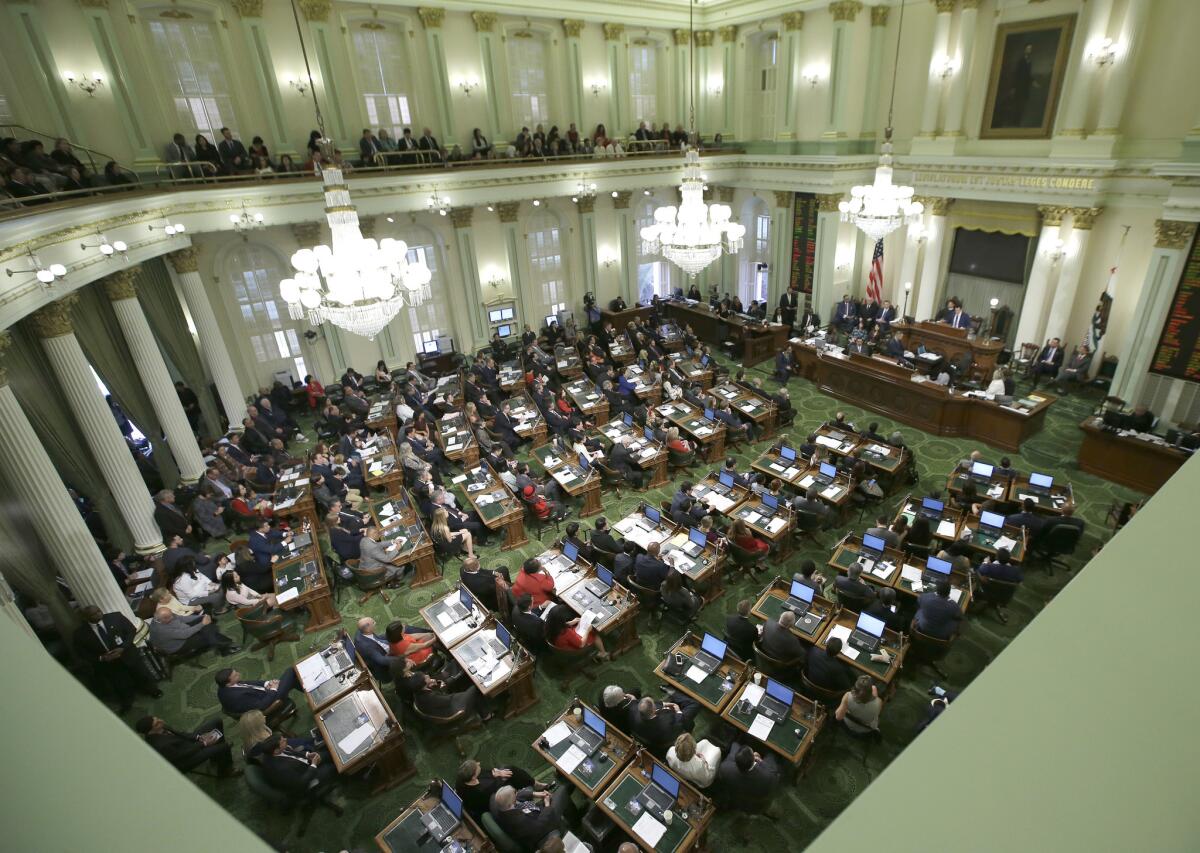Column: Political Road Map: Get ready for hundreds of extra bills in 2017

- Share via
Just minutes after taking the oath of office last week, new and returning members of the California Assembly received an early holiday gift, one that no lawmakers in Sacramento have been given for more than two decades.
They’ll be able to write more bills, an extra allotment totaling as many as 800 new pieces of legislation that could circulate through the state Capitol before the next election in 2018.
Legislators often have ideas for new state laws long before they unpack their bags in the capital city. Some are weighty efforts on complex policy issues; others are simple reactions to a perceived need, from new tax cuts to a crackdown on heinous crimes.
With a full-time Legislature and a robust community of professional lobbyists, the glut of ideas usually means some serious thinning of the herd. This time around, though, the Assembly has chosen to be more generous.
“Lots of people are bringing ideas forward,” said Assemblyman Ken Cooley (D-Rancho Cordova), the new chairman of the Assembly’s rules committee.
The decision to expand to 50 bills per Assembly member — a 25% increase from the 40-bill limit put in place in December 2002 — was tucked into a 69-page resolution last Monday that set in place the chamber’s organizational rules. The state Senate, on the other hand, kept in place its previous rule of only 40 bills per member.
In the last years of the 20th century, both houses had an even lower 30-bill limit for lawmakers.
There were 4,423 proposed statutes or constitutional amendments written by members of the Legislature in the most recent regular session, an average of about 37 bills per legislator. Tack on proposals written during special sessions on healthcare and transportation plus a potpourri of honorary resolutions — none of which count under the cap — and there were 5,103 bills.
Lots of people are bringing ideas forward.
— Ken Cooley (D-Rancho Cordova), chairman of the Assembly Rules Committee, on why Assembly members are being allowed to introduce more bills.
More than half made it to Gov. Jerry Brown’s desk, where he more often than not signed them into law.
Political Road Map: There’s a reason why Jerry Brown signs so many laws »
There was an era, of course, where lawmakers in the state Capitol could introduce as many bills as they wanted. In 1985, The Times published a story about one Van Nuys legislator who introduced 134 bills, many dealing with the insurance industry.
The Assembly’s decision to loosen its long-standing limits was only briefly mentioned when the chamber’s organizational rules were adopted last Monday, and only briefly criticized.
“I would imagine there’s increased taxpayer expense at that,” said Assemblyman Travis Allen (R-Huntington Beach).
Calculating the cost of more bills to be considered by the Legislature is dicey. While staff and facilities are already in place and paid for, workload would certainly increase. More bills could be introduced as placeholders for issues that might arise, the Capitol equivalent of an empty vessel waiting to be loaded up with cargo for an interest group that bends a lawmaker’s ear.
Cooley, who said the increased bill limit was in the works prior to his appointment as the overseer of the Assembly’s rules, said longer legislative term limits created four years ago have produced lawmakers with the expertise to handle more policy proposals.
“It gives them a little more room to exercise their responsibilities under the state Constitution,” he said.
Even so, the simple existence of any rule makes clear that a limit on bills is seen as a good thing, perhaps even a necessary thing when it comes to writing laws some 40 million Californians will ultimately be required to follow.
Follow @johnmyers on Twitter, sign up for our daily Essential Politics newsletter and listen to the weekly California Politics Podcast
ALSO:
California’s legislative session begins with a message: Bring on Trump
Political Road Map: California’s election maps, drawn without party favoritism, hit the halfway mark
Updates on California politics
More to Read
Get the L.A. Times Politics newsletter
Deeply reported insights into legislation, politics and policy from Sacramento, Washington and beyond. In your inbox three times per week.
You may occasionally receive promotional content from the Los Angeles Times.











